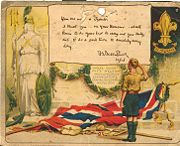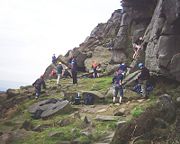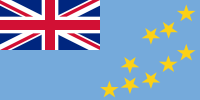The Scout Association
| The Scout Association | |
| Headquarters | Gilwell Park |
|---|---|
| Location | Chingford |
| Country | United Kingdom |
| Founded | 1907, incorporated 1912 |
| Founder | Baden-Powell |
| Membership | 365,685 youth 87,593 adults (2007)[1] |
| Chief Scout | Peter Duncan |
| Chief Executive | Derek Twine |
| Affiliation | World Organization of the Scout Movement |
| Website http://www.scouts.org.uk/ |
|
The Scout Association is the World Organization of the Scout Movement recognised Scouting association in the United Kingdom. Scouting began in 1907 through the efforts of Robert Baden-Powell. Due to the rapid growth of Scouting and a desire to remove control from the publisher of the Scouting magazine, The Scout Association was formed under its previous name, The Boy Scout Association, in 1910 by the grant of a charter by the Parliament of the United Kingdom. The Boy Scout Association was re-named as The Scout Association in 1967.
The stated aim of The Scout Association is to "promote the development of young people in achieving their full physical, intellectual, social and spiritual potential" and to create "responsible citizens".[2] As of 2007, The Scout Association provides a Programme to help achieve this aim for young people from the age of 6 to 25.[3] The latest census shows that over 360,000 people aged 6–25 are members of The Scout Association.[1]
Girls were first admitted in 1976 to the Venture Scouts, and the rest of Sections on an optional basis in 1991. Since 2007 all Scout Groups in the UK must accept girls as well as boys, although religious preferences can be accommodated.[4]
Contents |
History
Birth of the Movement

The roots of The Scout Association come from the fame of Robert Baden-Powell following his exploits during the Boer War. In 1907, "B-P", as he is known to all members of the Movement, ran a camp on Brownsea Island for teenage boys of varying backgrounds. This camp is now considered to be the start of the Movement.[5]
The following year, Baden-Powell wrote a series of magazines, Scouting for Boys, setting out activities and programmes which existing youth organisations could make use of.[6] The reaction was phenomenal, and quite unexpected. In very short time, Scout Patrols were created up and down the country, all following the principles of Baden-Powell's book. By the time of the first census in 1910, there were over 100,000 members of the Movement.[6]
The Boy Scout Association was created in 1910 in order to provide a national body which could organise and support the rapidly growing number of Scout Patrols. It was also the wish of Baden-Powell to wrest control of Scouting from his book's publishers as it was felt the Movement was not given the status it deserved as the publishers controlled membership of Scouting.[6]
1910–1920: Growth
Almost immediately, The Boy Scout Association was presented with a dilemma. Many of the boys in the Scout Patrols (at the start, Scouting was for boys between the ages of 10 and 19) had younger brothers who also wanted to participate. There were also many girls who wanted the same thing as well – Baden-Powell came across a group of Girl Scouts at the Crystal Palace Rally in 1910.[6] The solution for the younger boys was simple – the Wolf Cubs Section was created in 1917.[7] However, Edwardian principles could not allow young girls to participate in the rough and tumble, and "wild" activities of the Scouts, and so the Girl Guides were created by Baden-Powell's sister, Agnes, to provide a more "proper" programme of activities.[6] Many of those who had grown out of Scouts still wanted to be a part of Scouting, so another section was created in 1918 – the Rover Scouts.[8]
Scouting was now a global phenomenon, with a Royal Charter of 4 January 1912 incorporating The Boy Scout Association throughout the British Empire, with "the purpose of instructing boys of all classes in the principles of discipline loyalty and good citizenship", being granted by George V.[9] The first World Jamboree for Scouts was held in Olympia, London in 1920, and was a celebration and conference of the World Organization of the Scout Movement.[6]
1967–2003
Scouting in the UK went largely unchanged until it underwent a major review, the The Chief Scouts' Advance Party Report, and change in 1967. The name of the organisation was changed to be The Scout Association.[6] Major changes to the sections and their respective programmes were made – the youngest section were now named Cub Scouts,[6] the Boy Scout section was re-named simply as the Scout section, Senior Scouts became Venture Scouts[6] (for 16–20year olds), and the Rover Scout section was disbanded.[8] The Scout Uniform was also changed – most notably with the inclusion of long trousers for the Scouts (previously they had been wearing knee-length shorts).[6]
Several developments were made over the following years, including the introduction of co-educational units of boys and girls, initially restricted to the Venture Scouts section in 1976, but from 1991 junior sections were allowed to become mixed as well.[6] Parents involved in Scouting in Northern Ireland also began to organise activities for their children who were too young for Cub Scouts. This eventually led to the creation of the Beaver Scout section, officially starting in 1986.[6]
Despite these changes, and many other minor ones, Scouting started to fall into a decline through the 1990s with falling membership levels.[10] This spurred a major review into the causes of the decline,[11] followed by a programme change which took effect in 2003.[12]
2003–present
Scouting found itself competing for young people's time against longer school days and other extracurricular activities. The adult leaders are concerned with to the growing litigation culture in the UK.[13] Scouting has also been challenged by a negative stereotype as being old fashioned.[14]
The programme change in 2003 sought to overcome the growing challenges facing the Movement and saw changes at all levels of UK Scouting – the most apparent being the suspension of Venture Scouts. To replace this senior section, The Scout Association created the Explorer Scouts for 14- to 18-year-old members, and the Scout Network for 18–25 year olds.[12] The Scout Association also introduced a number of new badges, such as computing skills and skateboarding, to modernise the image of Scouting. These new badges drew mixed reactions from several public figures, with some praising The Scout Association for "moving with the times" and others feeling the changes went "against the Scouting ethos of Baden-Powell".[15]

Other changes in 2003 included changes to the leadership training so that it is more flexible, allowing for specific roles in the Movement, rather than the general leadership training which preceded it. New Scout uniforms for all sections and leaders were also introduced in 2003, with the aim of being more modern and appealing to young people.[16]
There have been many critics of these changes, mostly citing problems with the implementation, although recent census figures show a general upturn in membership, although this has mostly been at the lower age ranges.[13][17] Scouting in the UK continues to promote the same Principles and Methods as written by Baden-Powell in Scouting for Boys almost 100 years ago.
The UK played a major role in the centenary celebrations of Scouting in 2007, with celebration events organised on Brownsea Island,[18] as well as hosting the 21st World Scout Jamboree.
Organisation
The Chief Scout is the leader of The Scout Association, and is responsible for determining the direction and policies of Scouting in the United Kingdom and Overseas Territories. Peter Duncan is the current Chief Scout.[19] There is a team of Commissioners who are responsible for the Scouting programme in their respective divisions. These currently are:
- Nigel Hailey, International Commissioner
- Eleanor Lyall MBE, Chief Commissioner of Scotland
- Wilfred Mulryne OBE, Chief Commissioner of Northern Ireland
- Jill Gloster, Chief Commissioner of Wales
- John Asplin, Chief Commissioner of England
- Wayne Bulpitt, Chief Commissioner of England
- Tim Kidd, UK Commissioner for Adult Support
- Andrew Welbeloved, UK Commissioner for Programme
At all levels, Scouts are governed by an executive of non-Scouting trustees, known as executive committees[20] – these could be volunteers from the local community who have had ties with Scouting, either themselves or through their children. The executive normally consists of a chairman, secretary, treasurer, and a number of other officers. In Group Executive Committees, Group Scout Leaders and Section Leaders also form part of the committee.[21] Their role is to ensure that the best interests of the young people and the community are served by the Group, District, County, or National organisations.[20]
Senior volunteers in The Scout Association are called 'Commissioners'. Every County/Area/Region[22][23] and District[24] is headed by a Commissioner who is responsible for ensuring the Districts/Groups under their jurisdiction meet the standards set by The Scout Association. They receive support from Field Development Officers in England, who are employed by the Field Development Service and deployed locally to help support The Scout Association's objectives.[25] Commissioners in the other nations receive support from Field Commissioners, employed and directed differently. District Commissioners report to the County/Area/Regional Commissioner, who in turn report to the Chief Commissioner.
Structure
The Scout Association is divided into four mainland national groupings: England, Scotland, Wales, and Northern Ireland. Each of these divisions are further broken up into local Counties (England and Northern Ireland), Areas (Wales), or Regions (Scotland),[26] which generally follow the boundaries of the ceremonial counties of Great Britain. The County/Area/Region consists of a number of Scout Districts, which are made up of Groups.[26]

The Groups are the local organisations for Scouting, and are the direct descendants of the original Scout Patrols. Groups can consist of one or more Beaver Colonies, Cub Packs, and Scout Troops. Groups may also have one or more Group Scout Fellowships, and have an Explorer Scout Unit attached to it, though Explorer Scouts are managed at the District level.[27] Scout Groups are led by a Group Scout Leader whose main role is handling communication between the local District and the Section Leaders and ensuring the Scout Group meets the minimum standard required by The Scout Association.[28]
Sections
The first four sections (Beavers to Explorers) are led by a Section Leader, who must hold a warrant for the position, and is aided by assistant leaders.[29][30][31] Other adults who help run a Scout section may be volunteers (such as parents of children in the Group), Young Leaders (Explorer Scouts that have been trained to assist other leaders), and members of the Group Executive Committee who help operate the Group financially. Scout Networks are mainly member led, but are assisted by a Network Leader who ensures that the Network is working within the rules of the association.
All sections follow a progressive award scheme, culminating in the Queen's Scout Award, which is available to Explorer Scouts and members of the Scout Network who have undertaken and completed a wide range of activities and challenges.
| Section | Ages | Controlled by | Activities | Introduced | 2007 Membership[1] |
|---|---|---|---|---|---|
| Beaver Colonies | 6–8 | Group | Emphasis on having fun. | 1986 | 98,875 |
| Cub Packs | 8–10½ | Group | Introduction to Scoutcraft and activities. | 1916 | 132,853 |
| Scout Troops | 10½–14 | Group | Further development of Scouting skills. | 1907 | 102,542 |
| Explorer Scouts | 14–18 | District | Emphasis on personal challenge and adventure. | 2003 | 28,657 |
| Scout Network | 18–25 | County/Area | More flexible with greater personal choice. | 2003 | 1,758 |
In addition to the main programme sections, a parallel Scouting programme, Scoutlink, provides support and involvement for young people and adults with developmental disabilities.
Group branches
Some Scout Groups belong to separate branches called Air Scouts and Sea Scouts. Both branches follow the core programme in all Sections but can add more aeronautical or nautical emphasis depending on the branch, with some Group branches being recognised by the Royal Air Force or Royal Navy.
In the United Kingdom there are approximately 400 Sea Scout Groups, of which about 25% are Royal Navy recognised,[32] whilst of 117 Air Scout Groups, 43 are recognised by the RAF.[33]
Fund raising
Gimmie 5
The Gimmie 5 challenge is an annual fundraising event, aimed at Scout Groups in the United Kingdom. Organised by the World Wide Fund for Nature and the Scout Association, it lasts for 9 days in March every year. In 2006, it occurred from 18 to 26 March. Participating groups are required to raise money, in any way, with the proceeds shared between The Scout Association, the WWF and the Group. An earlier scheme at the same time of year was "Bob a Job Week" where Scouts raised money by doing jobs for their neighbours and were paid a shilling (a "Bob") for the work.
Campsites
Most Scout campsites are run by their Scout Districts and Counties, however there are four which have been made Scout Activity Centres, by The Scout Association. These are the main campsites in the UK and receive extra support from The Scout Association. The Scout Activity Centres are Baden-Powell House, Downe Scout Activity Centre, Gilwell Park, and Youlbury Scout Activity Centre.[34]
Notable former Scouts
-
For more details on this topic, see list of notable Scouts.
The Scout Association has had many notable members in the past, with the following selection being the best known:
- David Beckham – England international footballer and former captain
- Tony Blair – former Prime Minister of the United Kingdom
- Richard Branson – entrepreneur
- John Major – former Prime Minister of the United Kingdom
- Paul McCartney – singer/songwriter/bassist of the Beatles and Wings
- George Michael – singer/songwriter
- Cliff Richard – entertainer
- Keith Richards – member of the Rolling Stones
The Scout Association overseas
As well as controlling for Scouting in the United Kingdom, The Scout Association is also responsible for Scouting in the British overseas territories, as well as some small independent nations.[35] Non-sovereign territories with Scouting run by The Scout Association include:
|
|
Sovereign countries with Scouting run by The Scout Association, as they are without independent Scouting organisations, include:
 Antigua and Barbuda
Antigua and Barbuda Solomon Islands
Solomon Islands Saint Kitts and Nevis
Saint Kitts and Nevis Tonga
Tonga Tuvalu
Tuvalu Vanuatu
Vanuatu
The British Scout programme is also offered to British citizens living outside of the United Kingdom. British Scouts in Western Europe serves Belgium, France, Germany, Luxembourg, and the Netherlands[36] while British Groups Abroad covers the rest of the world.[37]
See also
- Brownsea Island Scout camp – the birthplace of World Scouting
- Scout Fellowship
- Girlguiding UK
References
- ↑ 1.0 1.1 1.2 "The Scout Association's Annual Report & Accounts 2006-07". The Scout Association. Retrieved on 2008-02-12. (taken from the Charity Commission's website)
- ↑ "Mission Statement". The Scout Association. Retrieved on 2007-08-18.
- ↑ "The 6-25 Programme". ScoutBase. Retrieved on 2007-08-18.
- ↑ "Rule 3.6: Mixed Membership" (html). Policy, Organisation and Rules. The Scout Association (2005). Retrieved on 2007-02-14.
- ↑ "Brownsea Island". Brownsea Island. Retrieved on 2007-08-19.
- ↑ 6.00 6.01 6.02 6.03 6.04 6.05 6.06 6.07 6.08 6.09 6.10 6.11 "The History of Scouting". ScoutBase. Retrieved on 2007-08-18.
- ↑ "Cub Scouts". Scouting Milestones. Retrieved on 2007-08-15.
- ↑ 8.0 8.1 "Rover Scouts". Scouting Milestones. Retrieved on 2007-08-15.
- ↑ "Royal Charter of The Boy Scouts Association". Scoutdocs. Retrieved on 2007-08-15.
- ↑ "The growing crisis in the Scout movement". Scout History Association. Retrieved on 2007-08-17.
- ↑ "UK Scouting plans its future". ScoutBase. Retrieved on 2007-08-17.
- ↑ 12.0 12.1 "New activity programme for UK Scouts". ScoutBase. Retrieved on 2007-08-17.
- ↑ 13.0 13.1 "The Gameboy generation returns to the Scouts". Daily Telegraph. Retrieved on 2007-08-20.
- ↑ "The Scout movement today". Saga. Retrieved on 2007-08-17.
- ↑ "Computing, faith and even PR, the Scout badges leading the pack". Daily Telegraph. Retrieved on 2007-08-19.
- ↑ "New Scout Uniform". ScoutBase. Retrieved on 2007-08-18.
- ↑ "A growing membership". The Scout Association. Retrieved on 2007-08-15.
- ↑ "Arriving at Brownsea", BBC South Today (2007-08-01). Retrieved on 2007-08-18.
- ↑ "Scouts honour for Blue Peter man", BBC News (2004-07-19). Retrieved on 2007-08-15.
- ↑ 20.0 20.1 "Charity Trustee". ScoutBase. Retrieved on 2007-08-19.
- ↑ "The Group Executive Committee". ScoutBase. Retrieved on 2007-08-18.
- ↑ "Role description for an Area Commissioner". ScoutBase. Retrieved on 2007-08-19.
- ↑ "Role description for a County Commissioner". ScoutBase. Retrieved on 2007-08-19.
- ↑ "Role description for a District Commissioner". ScoutBase. Retrieved on 2007-08-19.
- ↑ "Development Policy". ScoutBase. Retrieved on 2007-08-18.
- ↑ 26.0 26.1 "How we operate". The Scout Association. Retrieved on 2007-08-15.
- ↑ "The Scout Group: Introduction". ScoutBase. Retrieved on 2007-08-18.
- ↑ "The Scout Group: Responsibilities of Appointments in the Scout Group". ScoutBase. Retrieved on 2007-08-18.
- ↑ "The Scout Group: The Beaver Scout Colony". ScoutBase. Retrieved on 2007-08-18.
- ↑ "The Scout Group: The Cub Scout Pack". ScoutBase. Retrieved on 2007-08-18.
- ↑ "The Scout Group: The Scout Troop". ScoutBase. Retrieved on 2007-08-18.
- ↑ "Scouting Afloat" (pdf 96kb). The Scout Association (Nov 2004). Retrieved on 2007-08-16.
- ↑ "Air Scout Groups and Units". The Scout Association. Retrieved on 2007-08-16.
- ↑ "Scout Activity Centres". The Scout Association. Retrieved on 2007-08-18.
- ↑ "Overseas Branches of The Scout Association". ScoutBase. Retrieved on 2007-08-18.
- ↑ "BSWE Districts". British Scouts Western Europe. Retrieved on 2007-08-18.
- ↑ "British Groups Abroad". ScoutBase. Retrieved on 2007-08-18.
|
|||||
Age Groups in Scouting and Guiding around the world
|
||||||||
|
||||||||||||||||||||||||||||||||||||||||||||||||||||||||||||||
|
||||||||||||||||||||||||||||||||||||||||||